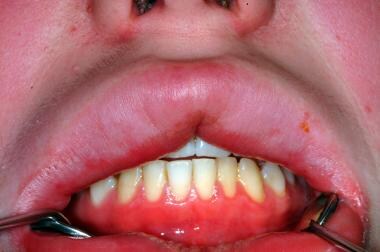Critchlow WA, Chang D. Cheilitis granulomatosa: a review. Head Neck Pathol. 2014 Jun. 8 (2):209-13. [QxMD MEDLINE Link].
Tummidi S, Nagendran P, Anthony ML, Ramani RJ, Shankaralingappa A, Gopinath H. Granulomatous cheilitis of Miescher: a rare entity. BMC Womens Health. 2023 Mar 21. 23 (1):118. [QxMD MEDLINE Link].[Full Text].
Sciubba JJ, Said-Al-Naief N. Orofacial granulomatosis: presentation, pathology and management of 13 cases. J Oral Pathol Med. 2003 Nov. 32 (10):576-85. [QxMD MEDLINE Link].
Wadhawan R, Singh Khurana PR, Khanduri N, Solanki G. Unveiling the curtain on orofacial granulomatosis: an overview. Acta Biomedica Scientia. 2015. 2 (3):148-151. [Full Text].
Nair SP. Cheilitis granulomatosa. Indian Dermatol Online J. 2016 Nov-Dec. 7 (6):561-562. [QxMD MEDLINE Link].
Miest R, Bruce A, Rogers RS 3rd. Orofacial granulomatosis. Clin Dermatol. 2016 Jul-Aug. 34 (4):505-13. [QxMD MEDLINE Link].
Rogers RS 3rd. Granulomatous cheilitis, Melkersson-Rosenthal syndrome, and orofacial granulomatosis. Arch Dermatol. 2000 Dec. 136 (12):1557-8. [QxMD MEDLINE Link].
Campbell H, Escudier M, Patel P, Nunes C, Elliott TR, Barnard K, et al. Distinguishing orofacial granulomatosis from crohn's disease: two separate disease entities?. Inflamm Bowel Dis. 2011 Oct. 17 (10):2109-15. [QxMD MEDLINE Link].
Jennings VC, Williams L, Henson S. Orofacial granulomatosis as a presenting feature of Crohn's disease. BMJ Case Rep. 2015 Jan 9. 2015:[QxMD MEDLINE Link].
Tilakaratne WM, Freysdottir J, Fortune F. Orofacial granulomatosis: review on aetiology and pathogenesis. J Oral Pathol Med. 2008 Apr. 37 (4):191-5. [QxMD MEDLINE Link].
Hornstein OP. Melkersson-Rosenthal syndrome. A neuro-muco-cutaneous disease of complex origin. Curr Probl Dermatol. 1973. 5:117-56. [QxMD MEDLINE Link].
McKenna KE, Walsh MY, Burrows D. The Melkersson-Rosenthal syndrome and food additive hypersensitivity. Br J Dermatol. 1994 Dec. 131 (6):921-2. [QxMD MEDLINE Link].
Morales C, Peñarrocha M, Bagán JV, Burchés E, Pelaez A. Immunological study of Melkersson-Rosenthal syndrome. Lack of response to food additive challenge. Clin Exp Allergy. 1995 Mar. 25 (3):260-4. [QxMD MEDLINE Link].
Wong GA, Shear NH. Melkersson-Rosenthal syndrome associated with allergic contact dermatitis from octyl and dodecyl gallates. Contact Dermatitis. 2003 Nov. 49 (5):266-7. [QxMD MEDLINE Link].
White A, Nunes C, Escudier M, Lomer MC, Barnard K, Shirlaw P, et al. Improvement in orofacial granulomatosis on a cinnamon- and benzoate-free diet. Inflamm Bowel Dis. 2006 Jun. 12 (6):508-14. [QxMD MEDLINE Link].
Ketabchi S, Massi D, Ficarra G, Rubino I, Franchi A, Paglierani M, et al. Expression of protease-activated receptor-1 and -2 in orofacial granulomatosis. Oral Dis. 2007 Jul. 13 (4):419-25. [QxMD MEDLINE Link].
Gavioli CFB, Nico MMS, Panajotopoulos N, Rodrigues H, Rosales CB, Valente NYS, et al. A case-control study of HLA alleles in Brazilian patients with Melkersson-Rosenthal syndrome. Eur J Med Genet. 2020 Jul. 63 (7):103879. [QxMD MEDLINE Link].
Saalman R, Sundell S, Kullberg-Lindh C, Lövsund-Johannesson E, Jontell M. Long-standing oral mucosal lesions in solid organ-transplanted children-a novel clinical entity. Transplantation. 2010 Mar 15. 89 (5):606-11. [QxMD MEDLINE Link].
Gale G, Östman S, Rekabdar E, Torinsson Naluai Å, Högkil K, Hasséus B, et al. Characterisation of a Swedish cohort with orofacial granulomatosis with or without Crohn's disease. Oral Dis. 2015 Jan. 21 (1):e98-104. [QxMD MEDLINE Link].
Mentzer A, Nayee S, Omar Y, Hullah E, Taylor K, Goel R, et al. Genetic Association Analysis Reveals Differences in the Contribution of NOD2 Variants to the Clinical Phenotypes of Orofacial Granulomatosis. Inflamm Bowel Dis. 2016 Jul. 22 (7):1552-8. [QxMD MEDLINE Link].
Haaramo A, Kolho KL, Pitkäranta A, Kanerva M. A 30-year follow-up study of patients with Melkersson-Rosenthal syndrome shows an association to inflammatory bowel disease. Ann Med. 2019 Mar. 51 (2):149-155. [QxMD MEDLINE Link].
Feng S, Yin J, Li J, Song Z, Zhao G. Melkersson-Rosenthal syndrome: a retrospective study of 44 patients. Acta Otolaryngol. 2014 Sep. 134 (9):977-81. [QxMD MEDLINE Link].
Xu XG, Guan LP, Lv Y, Wan YS, Wu Y, Qi RQ, et al. Exome sequencing identifies FATP1 mutation in Melkersson-Rosenthal syndrome. J Eur Acad Dermatol Venereol. 2017 May. 31 (5):e230-e232. [QxMD MEDLINE Link].
Smeets E, Fryns JP, Van den Berghe H. Melkersson-Rosenthal syndrome and de novo autosomal t(9;21)(p11;p11) translocation. Clin Genet. 1994 Jun. 45 (6):323-4. [QxMD MEDLINE Link].
El-Hakim M, Chauvin P. Orofacial granulomatosis presenting as persistent lip swelling: review of 6 new cases. J Oral Maxillofac Surg. 2004 Sep. 62 (9):1114-7. [QxMD MEDLINE Link].
Wehl G, Rauchenzauner M. A Systematic Review of the Literature of the Three Related Disease Entities Cheilitis Granulomatosa, Orofacial Granulomatosis and Melkersson - Rosenthal Syndrome. Curr Pediatr Rev. 2018. 14 (3):196-203. [QxMD MEDLINE Link].
Blinder D, Yahatom R, Taicher S. Oral manifestations of sarcoidosis. Oral Surg Oral Med Oral Pathol Oral Radiol Endod. 1997 Apr. 83 (4):458-61. [QxMD MEDLINE Link].
Girlich C, Bogenrieder T, Palitzsch KD, Schölmerich J, Lock G. Orofacial granulomatosis as initial manifestation of Crohn's disease: a report of two cases. Eur J Gastroenterol Hepatol. 2002 Aug. 14 (8):873-6. [QxMD MEDLINE Link].
Chu Z, Liu Y, Zhang H, Zeng W, Geng S. Melkersson-Rosenthal Syndrome with Genitalia Involved in a 12-Year-Old Boy. Ann Dermatol. 2016 Apr. 28 (2):232-6. [QxMD MEDLINE Link].
Rawlings NG, Valenzuela AA, Allen LH, Heathcote JG. Isolated eyelid edema in Melkersson-Rosenthal syndrome: a case series. Eye (Lond). 2012 Jan. 26 (1):163-6. [QxMD MEDLINE Link].
Khandpur S, Malhotra AK, Khanna N. Melkersson-Rosenthal syndrome with diffuse facial swelling and multiple cranial nerve palsies. J Dermatol. 2006 Jun. 33 (6):411-4. [QxMD MEDLINE Link].
Saito T, Hida C, Tsunoda I, Tsukamoto T, Yamamoto T. Melkersson-Rosenthal syndrome: distal facial nerve branch palsies, masseter myopathy and corticosteroid treatment. Fukushima J Med Sci. 1994 Jun. 40 (1):39-44. [QxMD MEDLINE Link].
Innocenti A, Innocenti M, Taverna C, Melita D, Mori F, Ciancio F, et al. Miescher's cheilitis: Surgical management and long term outcome of an extremely severe case. Int J Surg Case Rep. 2017. 31:241-244. [QxMD MEDLINE Link].
Reddy DN, Martin JS, Potter HD. Melkersson-Rosenthal Syndrome Presenting as Isolated Eyelid Edema. Ophthalmology. 2017 Feb. 124 (2):256. [QxMD MEDLINE Link].
Ekiz Ö, Rifaioǧlu EN, Şen BB, Çulha G, Özgür T, Doǧramaci AÇ. Leishmaniasis recidiva cutis of the lips mimicking granulomatous cheilitis. Indian J Dermatol. 2015 Mar-Apr. 60 (2):216. [QxMD MEDLINE Link].
Fitzpatrick L, Healy CM, McCartan BE, Flint SR, McCreary CE, Rogers S. Patch testing for food-associated allergies in orofacial granulomatosis. J Oral Pathol Med. 2011 Jan. 40 (1):10-3. [QxMD MEDLINE Link].
Banks T, Gada S. A comprehensive review of current treatments for granulomatous cheilitis. Br J Dermatol. 2012 May. 166 (5):934-7. [QxMD MEDLINE Link].
Campbell HE, Escudier MP, Patel P, Challacombe SJ, Sanderson JD, Lomer MC. Review article: cinnamon- and benzoate-free diet as a primary treatment for orofacial granulomatosis. Aliment Pharmacol Ther. 2011 Oct. 34 (7):687-701. [QxMD MEDLINE Link].
Saalman R, Mattsson U, Jontell M. Orofacial granulomatosis in childhood-a clinical entity that may indicate Crohn's disease as well as food allergy. Acta Paediatr. 2009 Jul. 98 (7):1162-7. [QxMD MEDLINE Link].
Kim SK, Lee ES. Orofacial granulomatosis associated with Crohn's disease. Ann Dermatol. 2010 May. 22 (2):203-5. [QxMD MEDLINE Link].[Full Text].
Kemmler N, Pfannschmidt N, Strohal R. Orofacial granulomatosis as first manifestation of Crohn's disease: successful treatment of both conditions with a combination of infliximab and dapsone. Acta Derm Venereol. 2012 Jul. 92 (4):406-7. [QxMD MEDLINE Link].
Adya KA, Inamadar A. Dermoscopy in the diagnosis and assessment of treatment response in granulomatous cheilitis. BMJ Case Rep. 2022 Jun 24. 15 (6):[QxMD MEDLINE Link].[Full Text].
Kern JA, Amanullah AA, Sahni DR, Mathis JG, Hull CM, Powell DL, et al. Granulomatous cheilitis - is there a role for allergen screening and avoidance?. J Dermatolog Treat. 2023 Dec. 34 (1):2171707. [QxMD MEDLINE Link].[Full Text].
White A, Nunes C, Escudier M, Lomer MC, Barnard K, Shirlaw P, et al. Improvement in orofacial granulomatosis on a cinnamon- and benzoate-free diet. Inflamm Bowel Dis. 2006 Jun. 12 (6):508-14. [QxMD MEDLINE Link].
Campbell H, Escudier MP, Brostoff J, Patel P, Milligan P, Challacombe SJ, et al. Dietary intervention for oral allergy syndrome as a treatment in orofacial granulomatosis: a new approach?. J Oral Pathol Med. 2013 Aug. 42 (7):517-22. [QxMD MEDLINE Link].
Kano Y, Shiohara T, Yagita A, Nagashima M. Treatment of recalcitrant cheilitis granulomatosa with metronidazole. J Am Acad Dermatol. 1992 Oct. 27 (4):629-30. [QxMD MEDLINE Link].
Fdez-Freire LR, Serrano Gotarredona A, Bernabeu Wittel J, Pulpillo Ruiz A, Cabrera R, Navarrete Ortega M, et al. Clofazimine as elective treatment for granulomatous cheilitis. J Drugs Dermatol. 2005 May-Jun. 4 (3):374-7. [QxMD MEDLINE Link].
Tonkovic-Capin V, Galbraith SS, Rogers RS 3rd, Binion DG, Yancey KB. Cutaneous Crohn's disease mimicking Melkersson-Rosenthal syndrome: treatment with methotrexate. J Eur Acad Dermatol Venereol. 2006 Apr. 20 (4):449-52. [QxMD MEDLINE Link].
Barry O, Barry J, Langan S, Murphy M, Fitzgibbon J, Lyons JF. Treatment of granulomatous cheilitis with infliximab. Arch Dermatol. 2005 Sep. 141 (9):1080-2. [QxMD MEDLINE Link].
Sobjanek M, Włodarkiewicz A, Zelazny I, Nowicki R, Michajłowski I, Sokołowska-Wojdyło M. Successful treatment of Melkersson-Rosenthal syndrome with dapsone and triamcinolone injections. J Eur Acad Dermatol Venereol. 2008 Aug. 22 (8):1028-9; author reply 1027-8. [QxMD MEDLINE Link].
Yadav S, Dogra S, De D, Saikia UN. Orofacial granulomatosis responding to weekly azithromycin pulse therapy. JAMA Dermatol. 2015 Feb. 151 (2):219-20. [QxMD MEDLINE Link].
Coskun B, Saral Y, Cicek D, Akpolat N. Treatment and follow-up of persistent granulomatous cheilitis with intralesional steroid and metronidazole. J Dermatolog Treat. 2004 Sep. 15 (5):333-5. [QxMD MEDLINE Link].
Hazey MA, Van Norman AJ, Armistead DL. Melkersson-Rosenthal Syndrome with migraine-like headaches treated with minocycline: a case report and review of the literature. W V Med J. 2009 Jan-Feb. 105 (1):15-7. [QxMD MEDLINE Link].
Ishiguro E, Hatamochi A, Hamasaki Y, Ishikawa S, Yamazaki S. Successful treatment of granulomatous cheilitis with roxithromycin. J Dermatol. 2008 Sep. 35 (9):598-600. [QxMD MEDLINE Link].
Williams PM, Greenberg MS. Management of cheilitis granulomatosa. Oral Surg Oral Med Oral Pathol. 1991 Oct. 72 (4):436-9. [QxMD MEDLINE Link].
Gu L, Huang DY, Fu CJ, Wang ZL, Liu Y, Zhu GX. Successful treatment of cheilitis granulomatosa by intralesional injections of pingyangmycin plus dexamethasone. Eur J Dermatol. 2016 Dec 1. 26 (6):627-628. [QxMD MEDLINE Link].
De Greef A, Peeters C, Dewit O, de Montjoye L, Baeck M. Upadacitinib for Treatment of Granulomatous Cheilitis. JAMA Dermatol. 2024 Sep 1. 160 (9):1001-1003. [QxMD MEDLINE Link].[Full Text].
Alves P, von Doellinger O, Quintela ML, Fonte A, Coelho R. Melkersson-Rosenthal Syndrome: A Case Report With a Psychosomatic Perspective. Adv Mind Body Med. 2017 Winter. 31 (1):14-17. [QxMD MEDLINE Link].
Kruse-Lösler B, Presser D, Metze D, Joos U. Surgical treatment of persistent macrocheilia in patients with Melkersson-Rosenthal syndrome and cheilitis granulomatosa. Arch Dermatol. 2005 Sep. 141 (9):1085-91. [QxMD MEDLINE Link].
Tan Z, Zhang Y, Chen W, Gong W, Zhao J, Xu X. Recurrent facial palsy in Melkersson Rosenthal syndrome: total facial nerve decompression is effective to prevent further recurrence. Am J Otolaryngol. 2015 May-Jun. 36 (3):334-7. [QxMD MEDLINE Link].
Silva Sousa P, Magalhães C, Cunha A, Castanheira A. Radiofrequency therapy as an effective treatment for granulomatous cheilitis: A CARE case report. Eur Ann Otorhinolaryngol Head Neck Dis. 2024 Jan. 141 (1):33-35. [QxMD MEDLINE Link].






